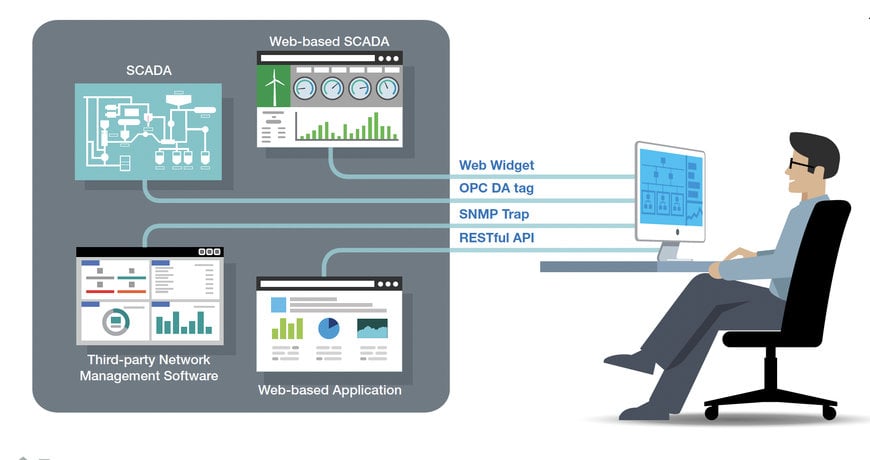www.magazine-industry-usa.com
12
'23
Written on Modified on
Three Tips from Moxa on Getting IIoT Networks Ready for the Future
Is your IIoT network ready for the new challenges coming over the horizon?.

When an Industrial IoT network is finally up and running, it may be tempting to rest on your laurels. Nonetheless, change remains the only real constant in the world of industrial networking. An IIoT network may be sufficient for your current needs. It may even be ready for foreseeable application requirements over the next several years. But what about the next decade? Change is always in the air, and you need to be prepared.
Since the early days of industrial automation, manufacturers have adopted a variety of purpose-built protocols and systems for highly specialized control applications, instead of using standard Ethernet technologies. However, as the IIoT continues to expand, industrial networks in the future will be required to transmit much larger volumes of data between interconnected devices and to collect information from remote devices for both OT and IT engineers to access. With these growing demands on the horizon, network preparedness may determine an enterprise's success.
Below are three tips from Moxa to help prepare your IIoT network for the future.
Tip One: Achieve Greater Integration with Unified Infrastructure
Over the years, various devices using different protocols have been deployed on industrial networks to provide diverse services. Under these circumstances, network integration usually costs more than expected or becomes more difficult to achieve. Manufacturers can either choose the status quo, that is, maintain their pre-existing isolated automation networks with numerous purpose-built protocols of the past, or seek solutions to deterministic services and that can integrate these “islands of automation” into one unified network.
If the goal is to be ready for future demands, the choice is obviously the latter. The rule of thumb is to take potential industrial protocols into consideration and ensure you can redesign networks in case any new demands arise in the market. One approach is Time-Sensitive Networking (TSN), a set of new standards introduced by the IEEE 802.1 TSN Task Group as an advanced toolbox. With TSN, you can build open, unified networks with standard Ethernet technologies that reserve flexibility for the future.
Tip Two: Enable Anywhere Access with Hassle-free Cloud Services
Cloud-based remote access offers many benefits to IIoT customers, such as reducing the travel time and expenses of sending maintenance engineers to multiple remote sites. Furthermore, cloud-based secure remote access can offer flexible and scalable connections to meet dynamic, fast-changing requirements. However, operational technology (OT) engineers may find it cumbersome to set up and maintain their own cloud servers for new services and applications. Indeed, there is considerable effort associated with setting up new infrastructure, even in the cloud. Fortunately, OEMs and machine builders can now deliver secure cloud-based services and remote access to their customers, therefore eliminating the need to maintain in-house cloud servers.
One key issue that definitely demands scrutiny is the cloud server license scheme. Often, upfront costs may seem low for limited server hosts. Yet these apparent cost savings on server hosts may actually make a project uneconomical due to a limited scale of connections. Second, you may also need to consider central management capabilities in order to flexibly expand remote connections as your needs change. With this said, carefully weigh the costs and benefits of incorporating secure remote access to industrial networks. Always select solutions that minimize hassles and will help deliver more value to customers.
Tip Three: Use Management Software for Better Visibility of Network Status
When complexity increases due to greater connectivity on industrial networks, it can become very difficult to identify the root cause of problems and maintain sufficient network visibility. Control engineers often have to revert to trial and error to get the system back to normal, which is time-consuming and troublesome.

Cloud-based secure remote access can provide flexible and scalable connections to meet the dynamic, changing requirements of the future.
In order to facilitate and manage growing industrial networks, network operators need integrated network management software to make informed decisions throughout network deployment, maintenance, and diagnostics. In addition, as systems continue to grow, it is important that you pay attention to a number of network integration concerns. First, only managing industrial networks in local control centers may not be feasible three or five years from now, especially when existing systems need to be integrated with new ones. It is therefore important to use network management software with integration interfaces, such as OPC DA tags for SCADA system integration or RESTful APIs for external web services. Furthermore, an interface to facilitate third-party software integration is also a key criterion for ensuring future flexibility.
For many industries, the IIoT presents as many challenges as opportunities. Nonetheless, this new frontier where traditional OT and IT silos converge is clearly the way of the future. Successfully deploying an IIoT application requires careful planning and attention to detail from the moment you decide to begin the journey. As a pioneering expert in industrial networking, Moxa provides a number of innovative technologies and solutions to help speed up network readiness for future IIoT applications.
www.moxa.com

